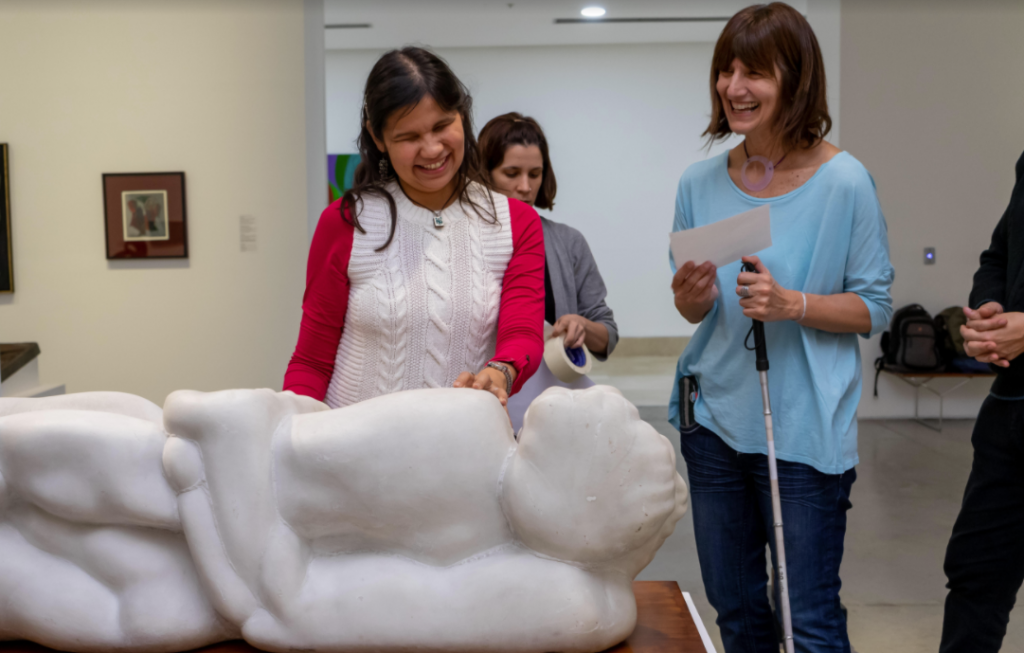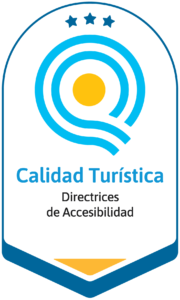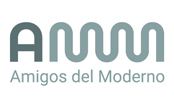As part of its commitment to accessibility, the Museo de Arte Moderno is committed to offering an inclusive experience. The museum aims to provide a quality service to the public based on the principal of universal design and through an educational program that includes activities designed for people with disabilities, as well as a wide variety of integrated activities that seek to promote participation, the exercise of citizenship and access to culture, thus enhancing the capabilities of all people.

The museum has an automatic door to enter the building, allowing for wheelchair access. The museum building is also free of architectural barriers, which makes it possible to move around the different spaces without encountering inconveniences or obstacles. The access door to the building is automatic and signposted with white vinyl stickers and logos.
Entry is free for people with disabilities and those accompanying them. The museum has free Wi-fi.
The reception desk is of regulatory height for wheelchair access. A transparent acrylic panel has been installed at the desk to ensure the safety of the staff.
The Háblalo app is available at the Museo Moderno to welcome and assist anyone with communication needs.
If you require any kind of medical assistance during your visit, ask a room guard or member of the security staff for help.
Our information and emergency signage uses internationally approved pictograms. Should you find any of the signage difficult to understand or identify, please ask reception or security staff for assistance.
The museum has a wheelchair available to visitors upon request, after registering their personal details at reception.
There is a lift located in the main hall which provides access to all floors of the museum, as well as two lifts located on the right hand side that provide access to the ground, first and second floors, and a service lift with access to all floors. There is also a wheelchair lift.
There are accessible toilets located on different floors of the museum.
On the first and second floors and the second sub-basement, they can be found across from the lift and in the education room.
All of the accessible toilets are equipped with baby changing facilities.
The shop, which is located to the right of the museum’s main entrance at the entrance to the café, is accessible by lift.
The café is located on the ground floor and visitors using wheelchairs can access it via the ramp.
The museum provides visitors with different spaces where they can rest and chat. Ask at reception for the opening hours of the café, terrace and education room. The museum has rest benches located in the circulation corridors of each floor as well is in some of the exhibition galleries.
The lifts are visually numbered and signposted with high relief contours and in braille. The lifts located to the right of Hall A are equipped with sound indications.
There are two haptic maps for the ground, first and second floors of the museum, and the second sub-basement has its own haptic map. These haptic maps have step counters and a system of tactile codes and braille letters to identify the different sectors of the museum, including the interior of each hall.
A tactile space can be found on the first floor at the entrance to the Education room. There you will find three 3D reproductions and a replica, with information in Braille.
Guide dogs and assistance dogs are admitted upon prior presentation of the appropriate documentation and with the use of an identifying vest.
Public transport to the Museo de Arte Moderno de Buenos Aires (CABA)
The following transportation routes stop near the Museo de Arte Moderno de Buenos Aires.
Bus: 126A, 152B, 159BG, 28B, 29B, 45, 8C, 93C
Train: MITRE, ROCA, SARMIENTO
Metro: A, C, D, E
Visitors arriving in adapted vehicles may park free of charge on Avenida San Juan or make use of the private car parks located near the museum.
The museum does not have its own parking facility.
The Museo Moderno offers different activities with the service of an Argentine Sign Language (LSA) interpreter, you can find these in the Agenda section.
Subtitled videos and activities with graphics can be found in the Education section.
You can find resources with audio descriptions in the Education section of our website.

The Museo Moderno offers different personalised visits and workshops with LSA, sensorial aids, clear language and pictograms (PECS)
The Ministry of Tourism and Sports has certified the compliance of the Museo de Arte Moderno de Buenos Aires with their Accessibility Guidelines, which represents an important recognition of our efforts to eliminate all barriers so that all of our visitors can enjoy the experience of visiting the galleries.
This distinction is a recognition of the work we have been undertaking since 2017 to expand the museum’s accessibility, which has led to the institution becoming a leader in guaranteeing the right of people with disabilities to fully participate in artistic experiences.

Thanks to the collaborators of the accessible project

